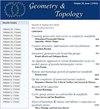2中的桥截与汤猜想
IF 2.2
1区 数学
引用次数: 10
摘要
在本文中,我们开发了一种新的技术来理解$\mathbb{CP}^2$中的曲面。三截面是一种光滑4流形拓扑的新方法,由Gay和Kirby提出,它提供了将三维工具应用于4维问题的途径。Meier和Zupan随后发展了4流形中平滑嵌入表面的桥式三割线理论。这些技术的主要应用是对Thom猜想的一个新的证明,该猜想假设$\mathbb{CP}^2$中的代数曲线在其同调类中的所有光滑嵌入的有向曲面中具有最小格。这个新的证明是值得注意的,因为它完全避免了任何规范理论或伪全纯曲线技术。本文章由计算机程序翻译,如有差异,请以英文原文为准。
Bridge trisections in ℂℙ2 and the Thom
conjecture
In this paper, we develop new techniques for understanding surfaces in $\mathbb{CP}^2$ via bridge trisections. Trisections are a novel approach to smooth 4-manifold topology, introduced by Gay and Kirby, that provide an avenue to apply 3-dimensional tools to 4-dimensional problems. Meier and Zupan subsequently developed the theory of bridge trisections for smoothly embedded surfaces in 4-manifolds. The main application of these techniques is a new proof of the Thom conjecture, which posits that algebraic curves in $\mathbb{CP}^2$ have minimal genus among all smoothly embedded, oriented surfaces in their homology class. This new proof is notable as it completely avoids any gauge theory or pseudoholomorphic curve techniques.
求助全文
通过发布文献求助,成功后即可免费获取论文全文。
去求助
来源期刊

Geometry & Topology
数学-数学
自引率
5.00%
发文量
34
期刊介绍:
Geometry and Topology is a fully refereed journal covering all of geometry and topology, broadly understood. G&T is published in electronic and print formats by Mathematical Sciences Publishers.
The purpose of Geometry & Topology is the advancement of mathematics. Editors evaluate submitted papers strictly on the basis of scientific merit, without regard to authors" nationality, country of residence, institutional affiliation, sex, ethnic origin, or political views.
 求助内容:
求助内容: 应助结果提醒方式:
应助结果提醒方式:


